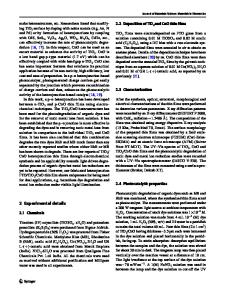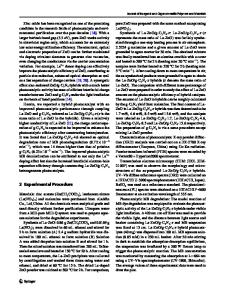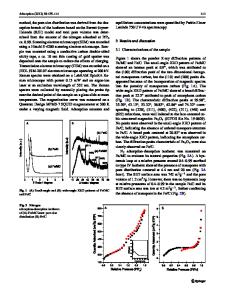Solution-processed P3HT-functional graphene for efficient heterojunction organic photoelectronics
- PDF / 705,657 Bytes
- 8 Pages / 584.957 x 782.986 pts Page_size
- 108 Downloads / 305 Views
Xueliang Li Department of Application Chemistry, School of Chemical Engineering, Hefei University of Technology, Hefei, Anhui 230009, China
Jianjun Zhao, Xuelan Mei, and Qian Li Department of Chemistry and Environmental Engineering, Bengbu College, Bengbu, Anhui 233030, China (Received 13 January 2016; accepted 9 June 2016)
A facile method that allows chemical functionalization of graphene sheets is described. These result in a solution processable graphene-based material, namely F-graphene, which can be integrated in organic photoelectronic devices, due to its unique structural and photophysical properties. The resultant poly(3-hexylthiophene)(P3HT):F-graphene are soluble in common organic solvents, facilitating the structure/property characterization and the device fabrication by solution processing. The synthesized F-graphene is blended with the conjugated polymer in optimized concentration. The high and sensitive photoresponse of P3HT:F-graphene was demonstrated by the photodetector. A heterojunction photovoltaic device based on the solution-cast P3HT:F-graphene (with a BHJ structure of ITO/ZnO/P3HT:F-graphene/MoO3/Ag) showed a power conversion efficiency of 1.9% under AM1.5 illumination (100 mW/cm2). It provides a new method for graphene application in organic photoelectronics. It can easily enhance the performance of devices by optimizing the structure and bulk heterojunction blend in the near future.
I. INTRODUCTION
Organic solar cells (OSCs) offer great technological potential as renewable and alternative sources of electrical energy.1–6 The possibility of using new organic semiconducting materials in place of silicon wafers in the fabrication of photovoltaic cells provides the prospect of lower manufacturing cost through the employment of various roll-to-roll techniques using solution-processable materials. In the field of organic photovoltaics, bulk heterojunction (BHJ) structures based on interpenetrating networks of conjugated polymers and fullerenes are the most intensely studied. Significant efforts have been applied toward improving the competitive power conversion efficiencies (PCEs) and the long-term air stability of OSCs.7–9 The most efficient OSCs have been based on BHJ devices composed of a blend of an electron-donating low-band-gap conjugate polymer such as poly(3hexylthiophene) (P3HT) and an electron acceptor such as fullerene or a fullerene derivative. Although both small molecules and polymeric materials with low-band-gap Contributing Editor: Sam Zhang a) Address all correspondence to this author. e-mail: [email protected] DOI: 10.1557/jmr.2016.243 J. Mater. Res., 2016
http://journals.cambridge.org
Downloaded: 20 Jul 2016
energies have been extensively investigated as p-type electron donor materials, not as many electron accepting fullerene derivatives have been actively studied because of difficulties associated with their synthesis. Thus, it is worthwhile to study new type of acceptor with good solubility and optimized energy levels.10–12 Novel carbon-based structures, such as carbon nanotub
Data Loading...










